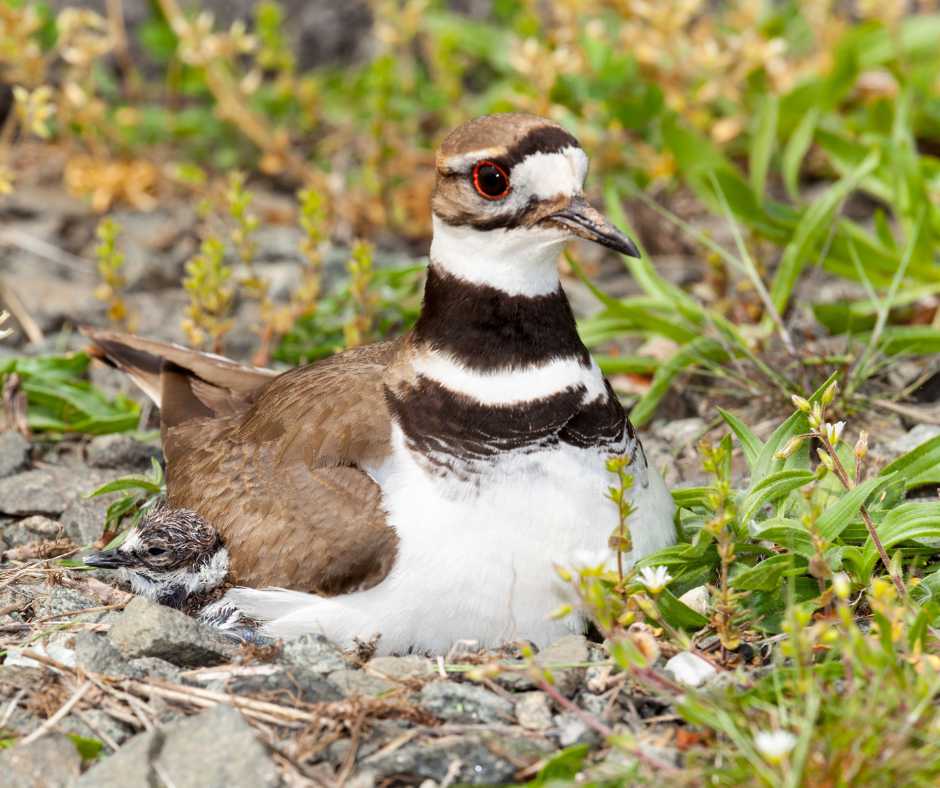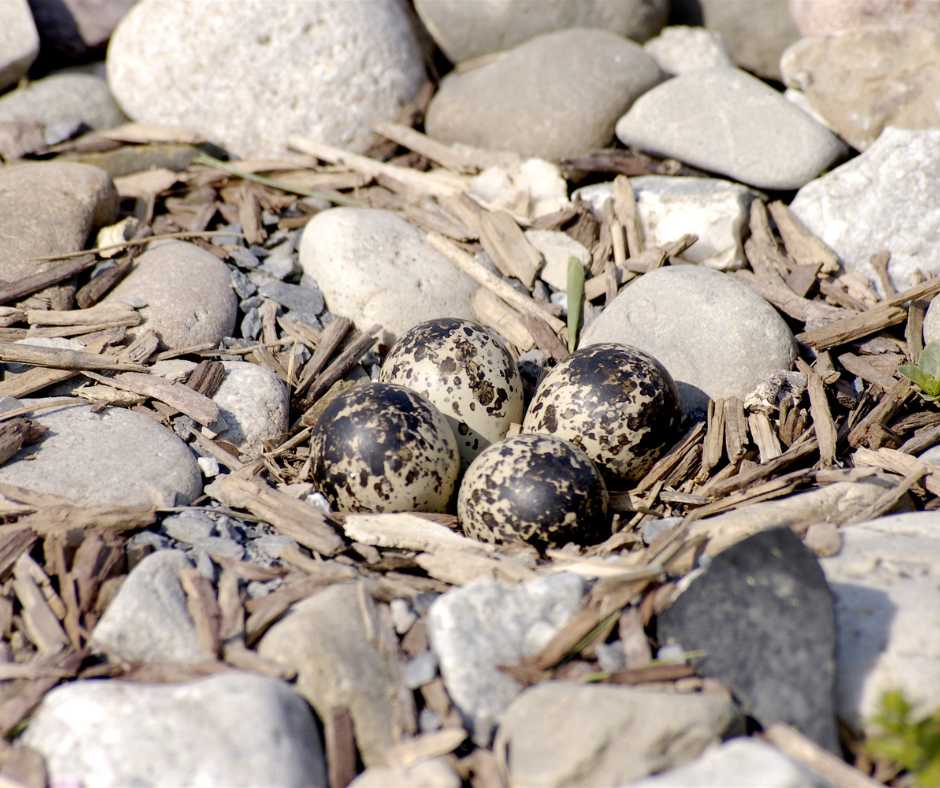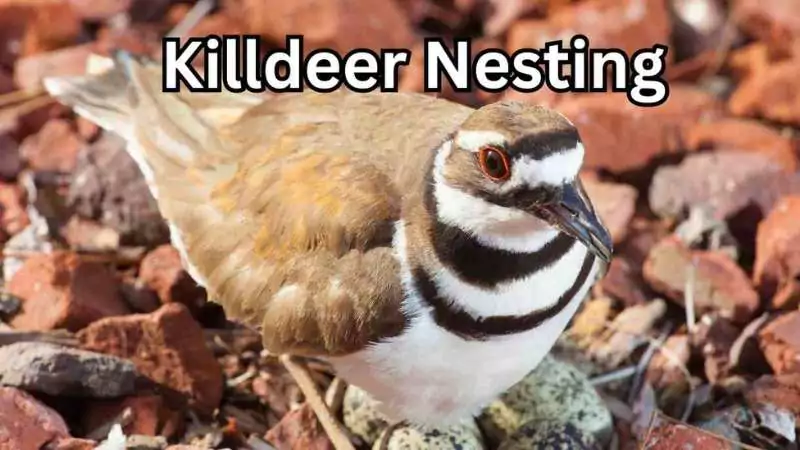Killdeer birds are incredible magicians of nature. They pick spots on the ground to lay their eggs, blending them to keep them safe from animals that might want a snack. It’s a smart move they’ve been doing for a long time. But, as we build more stuff, these birds need more space to call home. Ever seen a killdeer acting hurt in a parking lot? It’s trying to protect its nest.
In this blog, we’ll learn all about Killdeer nesting. You’ll learn where they nest, how they keep their eggs safe, and how we can live together without causing them trouble. We’ll also see how helping Killdeer helps lots of other animals. Let’s get started and find out how we can help these clever birds keep doing their thing.
| Aspect | Description |
| Nesting Location | Ground level, often in open fields or gravel areas for easy camouflage. |
| Reason for Ground Nesting | Easier to hide eggs from predators, using natural debris for camouflage. |
| Nest Appearance | Simple shallow bowl scratched into the ground, barely noticeable. |
| Parental Behavior | Known for dramatic “injury” displays to distract predators or humans from nests. |
| Seasonal Timing | Nesting season from early March through August, aligning with warmer temperatures for optimal egg survival. |
| Nest Building Process | Nests are made by pressing bodies into the earth, using local materials like twigs and stones for added camouflage. |
| Egg to Fledgling Journey | Eggs, camouflaged against the ground, hatch in about four weeks, with chicks quickly becoming mobile. |
| Survival Strategies | Multiple broods to spread predation risk, “broken-wing” act for predator distraction, and site fidelity for nesting. |
| Human Interaction | Adapt nests to human activity, showing resilience and the need for human awareness for their protection. |
| Conservation Importance | Highlighting the importance of coexistence and the role humans play in protecting these adaptable, yet vulnerable, birds. |
Unveiling the Mysteries of Killdeer Nests
Walking through your local park or even a bustling parking lot, you might stumble upon one of nature’s savvy survivors: the Killdeer. These birds need to do things the easy way. Nope, they’re ground nesters, choosing the earth’s floor over the safety of trees for a clever reason.
Why Killdeer Choose Ground for Nesting
Killdeer nests aren’t about catching your eye but staying invisible. These birds pick the ground for their homes because it’s easier to hide their eggs from predators. They’re the Houdinis of the bird world, masters of camouflage. Their nests blend so well into the surroundings that you might step right next to one and not even know it.
They use materials like twigs, stones, and other natural debris to make their eggs resemble another part of the ground. Smart, right? This isn’t a quirky preference; it’s a survival strategy honed over thousands of years. It keeps their future generations safe and sound.
Identifying Killdeer Nests: A Visual Guide
Now, spotting a killdeer nest can be a game. Imagine looking for a needle in a haystack, but the needle looks precisely like the hay. A killdeer nest is a shallow bowl scratched into the ground, often on gravel or bare soil. There’s no “nest” in the traditional sense – no twigs or leaves piled high—just a subtle, cozy scoop in the earth where the eggs lay.
The trick to finding these hidden treasures is to watch the parents. Killdeer are known for their dramatics, especially when they think you’re getting too close to their babies. They’ll put on a show, pretending to be hurt to lead you away. So, if you see a bird acting like it’s lost an Oscar, you’re probably near a nest.

Spotting one of these nests gives you a glimpse into the resilience and ingenuity of Killdeer. It’s a reminder that sometimes, the best secrets are hidden in the simplest places.
The Lifecycle of a Killdeer Nest
Diving into the world of Killdeer, we uncover a story that unfolds with the seasons. These birds, with their knack for adaptation, take us on a journey from the first whispers of spring to the chill that heralds winter’s return.
The Seasonal Timing of Nesting
As the frost retreats and the earth warms, Killdeer begin their annual nesting season. This period, stretching from mid March through August (source – Wikipedia), showcases the birds’ incredible flexibility.
They tune into nature’s signals, choosing the perfect moment to start their families. It’s a dance with the seasons, performed with precision and grace, ensuring their chicks have the best start in life.
Do Killdeer Return Annually?
When it comes to real estate, Killdeer has its favorites. Loyalty to a nesting site runs deep, with many returning to the same spot year after year. This remarkable site fidelity suggests that, for Killdeer, there’s no place like home. Killdeer birds like their nesting spots because they know the area well, and it feels safe.
Every year, they face the exact tough times to have their babies there. This shows how tough and smart they are, keeping going even when their homes change around them.
The Journey from Eggs to Fledglings
The story of a killdeer’s nest is one of growth, resilience, and the sheer force of life. It starts with eggs, each one a speckled masterpiece, laid gently in the nest. These eggs, camouflaged against the earth, hold the next generation of speedy runners. In about 22-28 days (source – All About Birds), they hatch, and the chicks emerge—fluffy, wide-eyed, and ready to explore.
Despite their tender beginnings, these fledglings are quick to find their feet. Within days, they’re darting about, guided by their parents’ watchful eyes and steady calls
Read more: When Do Blue Tits Nest.

From the first signs of life in the nest to the moment the fledglings spread their wings, the Killdeer’s nesting cycle is a testament to the enduring spirit of these birds. Each stage, from egg to flight, is marked by challenges, but the Killdeer’s journey is one of triumph, a cycle of life that continues with each passing year.
Deep Dive into How Killdeer Birds Nest
Looking into how killdeer birds nest is like discovering a secret world. These birds have some intelligent tricks up their feathers to keep their babies safe.
Constructing a Home: How Killdeer Build Their Nests
Imagine crafting a home with nothing but your body and the ground beneath you. This is the killdeer way. They find a spot that feels right—maybe it’s a patch of gravel or a stretch of bare soil—and they get to work.
With a shuffle here and a scoot there, they press their bodies into the earth, creating a cozy hollow. This simple act of nest-building is a marvel of nature’s design, blending simplicity with deep-rooted instinct.
How Killdeer Spread Out Their Chances
Killdeer birds don’t have one set of eggs at a time. Nope, they might have a few batches during the season. Why? It’s like not putting all your eggs in one basket. If something happens to one batch, they have others as backups. It’s an intelligent way to make sure more of their babies grow up.
Staying Safe from Danger
Since Killdeer build their nests on the ground, it’s easy for predators and even people to find them. But Killdeer has a secret weapon. They pretend to have a broken wing to lead threats away from their nest. It’s a trick to protect their eggs and babies.
And with people and buildings taking up more space, Killdeer have to be extra clever about where they make their homes. They pick spots where they will only be bothered a little.
When we learn about how Killdeer birds nest, we see they’re good at making plans, staying safe, and being loyal to their homes. It’s super interesting to see how these birds, which might look fragile, are fearless and clever at living their lives.
Engaging with Killdeer: Guidelines for Humans
When it comes to sharing our spaces with Killdeer, it’s all about respect, empathy, and a bit of creativity. Here’s how we can live in harmony with these fascinating birds.
Can You Safely Move a Killdeer Nest?
Stumbling upon a killdeer nest in your backyard or during a construction project can feel like a delicate dilemma. The urge to move the nest to a safer location might be strong, but it’s essential to hit the pause button on that thought. Relocating a killdeer nest is a tricky business for the birds’ well-being and the legality of the action.
Before making any moves, reaching out to local wildlife authorities is a must. They can provide guidance and, if necessary, professional assistance to ensure any intervention is safe and legal. Remember, the goal is to protect these little residents without stepping on nature’s toes, so learn about wildlife laws here.
Fostering a Safe Environment for Nesting in Your Backyard
Creating a killdeer-friendly zone can be a manageable backyard overhaul. These birds are low-maintenance if you know what they need. A little patch of gravel or a bare spot of ground can become prime real estate for a killdeer looking to settle down.
If you leave some areas of your yard wild and clean up only some of the sticks and leaves, you’re making an excellent spot for Killdeer birds to move in.
Also, making sure pets and kids stay away from these areas when Killdeer are nesting means the birds can take care of their babies without any trouble. It’s all about coexistence, respecting their space as they adapt to ours. For more tips on creating wildlife-friendly spaces, check this out.

Living with killdeer birds around us is pretty cool. It’s like having a front-row seat to a fantastic nature show in our backyards. If we follow a few simple rules, we can help these birds keep doing well. This way, we get to enjoy having them around and learn how awesome it is to share our space with wild animals.
People Also Asked
What should I do if I find a killdeer acting injured?
It’s likely a decoy to lead you away from its nest. Give the area a wide berth to avoid disturbing any hidden nests.
How can I help protect killdeer nests in urban areas?
Raise awareness! Informing your community about these birds can help prevent accidental disturbances to their nesting sites.
Is it common for a killer to nest in the same place every year?
Yes, many Killdeer return to familiar territories each year to lay their eggs and raise their chicks.
How long does it take for killdeer chicks to learn to fly?
Killdeer chicks are born ready to run, but it takes about a month for them to take their first flight.
Can landscaping affect killdeer nesting?
Absolutely. Maintaining areas of gravel or bare ground in landscaping designs can provide essential nesting sites for Killdeer.
Conclusion: Our Role in the Story of Killdeer Nesting
Killdeer birds are amazing. They don’t get by; they know how to make the best of things, even when it’s tough. They teach us how important it is to keep trying and to be smart about where and how we live.
But learning about Killdeer isn’t for fun. It’s a reminder that we all need to help take care of them and other wildlife. We can start in our backyards or schools by keeping places safe for birds and letting others know how excellent and essential Killdeer are.
If we all do a little bit to help, we can make a big difference for Killdeer and many other animals. Let’s make sure we can always hear Killdeer and see them doing their thing because they’re a particular part of nature.

